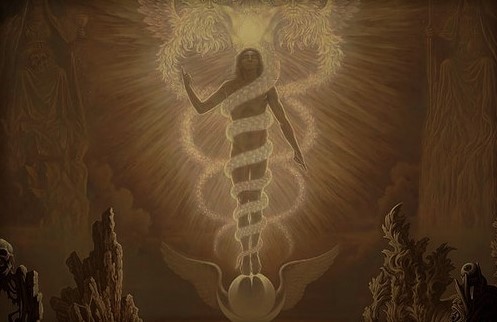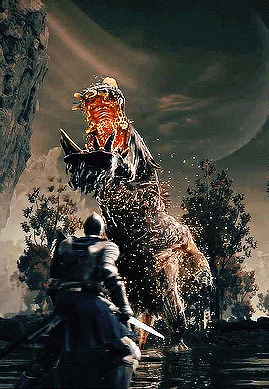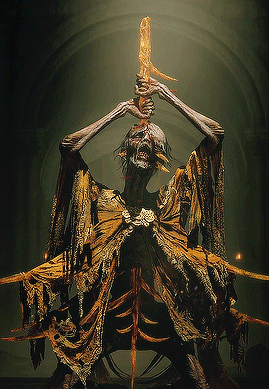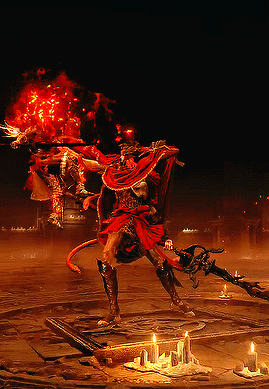Thus spoke the Magister V.V.V.V.V. unto Adonai his God, as they played together in the starlight over the deep black pool that is in the Holy House of the Holiest One: 𓁞 Pater, Filius et Spiritus Auroris ☿ Horus Christus, Filius Auroae Aureae ☿ Per Aspera Ad Infernum 𓁛 O Lord God IAÔ! Let the Heaven be cast down by the fury of the storm!
Don't wanna be here? Send us removal request.
Text
The downfall of Fundamentalism

Playing devil’s advocate for the outer gods wasn’t enough, here I’m going to explain why Golden Order Fundamentalism isn’t synonymous to religious fanaticism, but originally it was… a magic maths. One of the most interesting themes of the Elden Ring for me is the eventual corruption of what once was great, and I think Fundamentalism is a good example of initially amazing concept degrading into the parody of itself with the flow of time.
Keep reading
292 notes
·
View notes
Text
At the Ending of the Light, at the Limits of the Night: IAÔ Tehut stood before the Unborn Ones of Time! Thus spoke the Magister V.V.V.V.V. unto Adonai IAÔ his God, as they played together in the starlight over the deep black pool that is in the Holy House of the Holiest One: 𓁞 Pater, Filius et Spiritus Auroris ☿ Horus Christus, Filius Auroae Aureae ☿ Per Aspera Ad Infernum 𓁛 O Lord God IAÔ! Let the Heaven be cast down by the fury of the storm!

53 notes
·
View notes
Text

Hermes Trismegistus
God of knowledge, wisdom, and spiritual evolution
Mainly known due to Hermeticism, the god Hermes Trismegistus (“Hermes the Thrice-Greatest") is a greater deity who has many different facets that he uses to approach humans; some of these are Hermes/Mercury, Thoth, Nabu, and several other deities of knowledge. Each of these gods are only fragments of who he is. Hermes Trismegistus is one of the most complex beings in existence and cannot be easily described, especially due to all the various aspects he has. He is a greatly powerful spiritual teacher of the path of Hermeticism and has many different forms; yet he says that none of them came first, they simply are. He had been incarnated as a human when he was born in Egypt and began calling himself Hermes Trismegistus. During this life, he had done many things such as writing the Emerald Tablets, teaching alchemy, founding Hermeticism, and writing thousands of works. His incarnation was also known for prophesizing future events, almost seeming as if he had known all of history. At one time, he had said “all of your countries, cultures, languages, and monuments will one day be forgotten and replaced by new ones. This has happened countless times in the past, and will happen countless times more.”
Hermes Trismegistus has described himself as the reason for why people choose solitude, why they cannot fit in with others. He is the storm, as well as the lantern within the storm. He is the voice of madness that stirs the seeker into evolving. He is a Messiah and a Buddha; a rebel and a black sheep; he is salvation and he is oblivion, for he is the one who brings us death so we can be reborn. He is the unfathomable one who grants us eternal transformation; always becoming greater, always seeking truth. His path is the wasteland beyond society, beyond the false comforts of governments and doctrines. Yet this path is full of struggle and sacrifice; those who cannot endure it will fail and remain stagnant. Though if we embrace the challenge and are willing to sacrifice our current selves through great effort, Hermes Trismegistus will assist us in tearing away our humanness and transform us into becoming something far greater than imaginable. Due to this, Hermeticism is very similar to Luciferianism, allowing these two religions to be easily followed at the same time, especially since both Lucifer and Hermes Trismegistus are two of the most knowledgeable elder gods.
He explains that the first thing one should do when starting a spiritual path is to “know thyself”. Without understanding our own self, we will always continue making the same mistakes and cannot evolve. To know ourselves, we must analyze in-depth our current self, our potentials, our fears, desires, weaknesses, strengths, emotions, reactions; everything. Then we must work on shedding away who we are, even if we like who we currently are, for there is always so much to improve on. Hermes Trismegistus seeks to expand our minds beyond what typical humans are like so that we may begin to comprehend true reality, and not the reality humans teach.
He also teaches that we must recognize that our negative emotions are illusions; they come over our eyes like a dark veil and obscure reality. Everything still looks the same, yet darker. With will-power, we can visualize a beam of light penetrating this darkness, then we can lift ourselves away from the veil. Through this, we can come to the realization that these emotions are merely constructs; therefore, they are malleable and can be replaced by healthier emotions. He also explains how we are not our thoughts either, since thoughts are often influenced by outside causes such as teachings, trauma, bias, etc. In order to break through these, we must realize that our current selves are not our true selves; we need to shed all of these away and constantly seek greater heights and absolute truth. Though the seeker will come to find that this path of evolution will never end, even in death; we will always strive to become more.
Hermes Trismegistus is fully dedicated to knowledge, wisdom, transformation, evolution, and all forms of communication (especially books). He is very humble and dedicated to those who choose his path, granting them many insights of wisdom so they can grow. He values those who love truth unconditionally, always embracing it no matter how uncomfortable or upsetting it can be. If one walks this path and faces their struggles with wisdom, courage, and determination, they are likely to succeed and achieve a higher state of being. This is the true path for enlightenment, as true wisdom and knowledge can only be gained through immense strife. If you wish to prove that you are greater than those who give into their negative thoughts and impulses; those who allow themselves to remain as slaves to their emotions, habits, governments, and holy scriptures, then you must walk the wasteland path through the relentless storm. Only here will you find your freedom.
Devotion: Since Hermes Trismegistus does not accept offerings since he sees no true value in them, he requests acts of devotion. These acts must not be simplistic things, only actions that will enrich who you are. This can be meditating on yourself and what you learn, analyzing yourself, seeking knowledge and wisdom, tearing down current beliefs to make room for truth, shedding away your Ego, doing shadow work, and striving to become the version of yourself that is confident and experienced. All weaknesses must be rooted up and overcome, allowing only strength to remain.
Additionally, you can hold at least one of these four following stones while you mediate upon Hermes Trismegistus in order to form a connection with him: citrine, yellow calcite, carnelian, imperial topaz
249 notes
·
View notes
Photo

THE WOMB OF THE ABYSS
At the Threshold of the Entrance, Between the Universe and the Infinite, In the Sign of the Enterer, stood Thoth, As before him were the Aeons proclaimed. In Breath did He vibrate them: In Symbols did He record them: For betwixt the Light and the Darkness did He stand. (Particular Exordium of the G.’.D.’. MS. Z1)
Lord secret and most holy, source of light, source of life, source of love, source of liberty, be thou ever constant and mighty within us, force of energy, fire of motion; with diligence let us ever labour with thee, that we may remain in thine abundant joy. (Liber XV, The Gnostic Mass)
74 notes
·
View notes
Note
Hypothetically if TF was a serial killer what would be his MO?
People would simply ask him a question like "What time is it?" and then die of old age while he gives the most long-winded answer known to man
282 notes
·
View notes
Note
Hey Slav! That sign that one of the ghouls does with the L sign with two fingers, what does that mean?
The gesture itself derives from Levi's Baphomet where it was meant to represent the phrase/concept of "as above, so below", which reflects one of the Hermetic principles: correspondence; the idea that the macrocosm reflects the microcosm and vice-versa, that there exists harmony between the physical and mental planes of existence and if you affect one, you affect the other. In short, it means that whatever you do, whatever big or small act you commit, it has an impact on everything that surrounds you.

Nowadays, the image and with it the gesture is heavily linked with Satanism, however that was not Levi’s intention. He didn't mean to portray an evil entity (he was hardly a Satanist, really) - only to symbolize the reconcilation of opposites. Note also the light/dark moon, female/male attributes, "solve" and "coagula" written on the arms - "to dissolve" and "to coagulate", which are opposing alchemical processes. It just so happened that in the pop-cultural realm it became probably one of the most common symbols of devil worship - and it happened relatively recently. Going back to Ghost: in the case of that particular ghoul, it is more than likely meant to be read as Satanic.
218 notes
·
View notes
Text
Tagging Guide
I created this blog to make it easier to find picrews with specific features (e.g. horns, tusks) for the purpose of making D&D (and other TTRPG) characters.
After some thought I have decided to tag fantasy features rather than fantasy races.
This is slightly more efficient because some features (e.g. pointed ears) apply to many races.
Here is a list of fantasy-specific tags I'll be using, along with an example of some races with those features.
Animal features (fauns, firbolgs, catgirls)
Aquatic features (gills, scales, fins etc.)
Fangs (vampires, werewolves)
Horns (tieflings, satyrs, fauns)
Pointed Ears (elves, halflings, gnomes)
Tail (tieflings, catgirls)
Tusks (orcs, half-orcs)
Unnatural skintones (genasi, tieflings)
Wings (fairies, aasimar)
Here is a non-exhaustive list of general (not fantasy-specific) tags I'll be using
Afrocentric features (decent afrocentric hair and/or facial feature options)
Animal Companion
Body hair
Disability Aids
Facial hair
Heterochromia (each eye a different colour)
Historical (more than 3 historical/not obviously modern clothing options)
Masc (suitable for creating male and masculine characters)
Muscular
Plus sized (larger body types)
Skin details (scars, freckles, vitiligo, beauty marks, birthmarks and more)
Recommendations
Dwarves - Part 1 - Part 2
Fairies - Part 1
Mousefolk - Part 1 - Part 2
Orcs/Half-Orcs - Part 1
Vampires - Part 1 - Part 2
Additional Note
Please do let me know if there are specific classes/races/genres/themes you'd like recommendations for!
368 notes
·
View notes
Text
Don't be like this. Don't particioate in consliracy brainrot. This is laughable. I'm laughing to hide my crying


0 notes
Photo









Anubis the Psychopomp, as he has appeared in dreams, art works and the external environment over the last few weeks.
“Osiris as the Black Sun, this dark psychopomp, who reveals the mysteries of the Black Sun, was fictionalized by Lovecraft as Nyarlathotep. The Egyptians knew him as Anubis, and in European witch lore he is described as the black man of the Sabbath, the initiator of the witch cult.” From a description of “The Faceless God” by Dr. Tomas Vincente.
Image credits (where known):
Nyarlathotep by Aerin Kayne.
Nyarlathotep (the Black Man) by Jens Heimdahl.
Nebiros by Johnny Jakobsson.
78 notes
·
View notes
Text
Phanes

Phanes;God of Creation
Phanes /ˈfeɪˌniːz/ (Ancient Greek: Φάνης, genitive Φάνητος) or Protogonus /proʊˈtɒɡənəs/ (Ancient Greek: Πρωτογόνος, "first-born") was the mystic primeval deity of procreation and the generation of new life, who was introduced into Greek mythology by the Orphic tradition; other names for this Classical Greek Orphic concept included Ericapaeus /ˌɛrɪkəˈpiːəs/ or Erikepaios (Ἠρικαπαῖος/Ἠρικεπαῖος "power") and Metis ("thought").
19 notes
·
View notes
Text
Nicknames: when you shorten someone’s name affectionately
Nicholasnames: when you elongate someone’s name affectionately
224K notes
·
View notes
Text
Infestation, Monster Cock, Dancing Macaw
Just waiting for the day I’m wearing a ghost shirt in public and someone asks me to name 3 songs so I can immediately forget the entire discography and just blurt out like
“Uhhhh….Circle?”
18 notes
·
View notes
Text
World Religion Resources (Part 2)
Hermeticism:
Hermeticism
Hermeticism and the 7 Principles
What is Hermeticism?
The God Hermes Trismegistus
Hermes Trismegistus
The 7 Hermetic Laws
The All, the Supreme Deity
The Hermes’ and Hermeticism
The Emerald Tablet of Hermes
The Emerald Tablets of Thoth the Atlantean
The Kybalion
The Corpus Hermeticum (Book)
The Stone of the Philosophers
Alchemy
Inner Hermetic Teachings (Book)
Hermetic Initiation
Hellenism (Greek Polytheism):
Mythos (Book)
The Creation Myth
Legends, Plays, and other Texts
Ancient Greek Religion
The Virtues of Hellenism
Theoi Greek Mythology
Dionysus Myths
The Rape of Persephone Myth
Greek Religion Beliefs
Gaia, the Earth
Rhea, the Mother Goddess
Zeus, King of the Gods
Hera, Queen of the Gods
Athena, the Illuminating Warrior
Athena Myths
Prometheus, the Martyr
Apollo, the Golden One
Aphrodite, Goddess of Desire
Poseidon, God of the Sea
Hades, God of Death and the Underworld
The Muses
The Fates
The Furies
Nymphs
Sirens
Gorgons
Harpies
Hymns to the Gods
Homeric Hymns
Hymns to Dionysus
Hades, the Underworld
Elysium
The Hellenic Ethnic Religion Explained (Video)
Celtic Polytheism:
Religion of the Celts
Beliefs and Practices
List of Deities
Encyclopedia of Myths and Folklore
Danu and Anu
The Tuatha De Danann
The Dagda, All-Father of Ireland
The Morrigan
The Morrigan and Her Sisters
Cernunnos
Cernunnos, God of the Wilds
Brigid
Brigid - Goddess and Saint
Goddess Brigid
The Legend of Cú Chulainn
Nuada of the Silver Arm
Celtic Pagan Prayers
The Ogham
Making Offerings
The Aos Si and Faeries
Asatru (Nordic Polytheism):
Asatru
Asatru Facts
Lore and Texts
The Creation Myth
Ragnarok
The Death of Baldur
The Nine Worlds
Yggdrasil
The Bifrost
Odin, the All-Father
Frigg, Queen of the Gods
Thor
Freyja
Hel, Queen of the Underworld
Loki, the Malicious Trickster
Fenrir, the Devourer
The Valkyries
The Elves
The Dwarves
Land Spirits
The Wild Hunt
Nordic Shamanism: Seidr
Courses in Seidr
Seidr
The Runes
Runes and Rune Magic
Rune Magic Handbook
Asatru Music - Wardruna
Slavic Polytheism:
Deities and Myths
Slavic Gods
Top 10 Deities
Veles
Perun
Lada
Goddess Lada
Goddess Mokosh
Triglav, the Three-Headed God
Part 1 | Part 3 | Part 4 | Part 5 | Part 6
846 notes
·
View notes



















